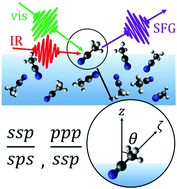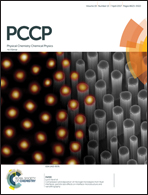Theoretical and experimental examination of SFG polarization analysis at acetonitrile–water solution surfaces†
Abstract
Sum frequency generation (SFG) spectroscopy is widely used to observe molecular orientation at interfaces through a combination of various types of polarization. The present work thoroughly examines the relation between the polarization dependence of SFG signals and the molecular orientation, by comparing SFG measurements and molecular dynamics (MD) simulations of acetonitrile/water solutions. The present SFG experiment and MD simulations yield quite consistent results on the ratios of χ(2) elements, supporting the reliability of both means. However, the subsequent polarization analysis tends to derive more upright tilt angles of acetonitrile than the direct MD calculations. The reasons for discrepancy are examined in terms of three issues; (i) anisotropy of the Raman tensor, (ii) cross-correlation, and (iii) orientational distribution. The analysis revealed that the issues (i) and (iii) are the main causes of errors in the conventional polarization analysis of SFG spectra. In methyl CH stretching, the anisotropy of Raman tensor cannot be estimated from the simple bond polarizability model. The neglect of the orientational distribution is shown to systematically underestimate the tilt angle of acetonitrile. Further refined use of polarization analysis in collaboration with MD simulations should be proposed.



 Please wait while we load your content...
Please wait while we load your content...